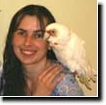Preparing Your Birds For Show
Kristen Reeves, Meadowlark Farms Avian Supply, Inc.
Folks often ask what it is I do to prepare my birds for a bird show. Preparing the actual bird is the easy part. Choosing the birds to show is a bit more tenuous. In this article I will discuss how I go about choosing the birds I show, and then how I prepare those chosen birds for the show bench.
SELECTING BIRDS TO SHOW
I have a very specific shape and conformation in my mind that I think is the perfect bird. I spend the entire year watching ALL of my birds closely. I watch their movements, their stance, their overall shape and size, their color. By the end of summer, I typically know which birds I will pull to show.
The very first thing I do is remove any bird I wish to show to its own cage – or with only one other bird in the cage. This cuts down on feather damage. I make sure the birds I place together are fully compatible and do not fight. The last thing I want to see are missing or broken feathers or injuries from a fight. Birds who are not compatible or who are in breeding condition will often fight. They see the other bird as a competitor. They will pull each others’ feathers and get pretty nasty. I have to be extremely vigilant – and move any bird that can’t get along with its cage mate.
Next, I offer the birds bath water daily, sometimes more than once daily. Bathing is one of my birds’ favorite pastimes. But it also promotes good preening. Clean feathers glow and shine. Preened feathers stay neat and tidy against the body.
Once I’m certain I have the birds I wish to show pulled from the various cages, I then place each bird in a show cage. I line all of the cages up on the bench and compare one to another. I look for size, shape, feather quality, and overall condition. As I compare birds, I remove those that probably won’t do well on the bench or those of lesser quality until I have only the best birds from those selected to show.
PREPARING SELECTED BIRDS – 8 WEEKS BEFORE A SHOW
Approximately 8 weeks before show season (which starts in October in Michigan), I pull each of the birds I’ve decided to show and trim their nails and beaks. I check their overall health and condition, and condition the nails and beaks with Carmex regardless of what I find. I file anything that needs to be smoothed out (See our Show Preparation Video Series here). I pull out each wing and remove any broken or frayed feathers. If either of the tail wires on cock birds are broken, I pull out BOTH so that they grow back at the same rate and are the same length. There must be TWO tail wires, and they SHOULD be the same length. Feathers are typically replaced within about 6 weeks when the birds are offered optimal nutrition. Doing this at 8 weeks gives them extra time before the show to replace the feathers in case they grow slower than average.
If there are any pin feathers, I use a soft toothbrush to brush them out. Sometimes the feather cuticle is not quite ready to come off, so I work at it over the course of several weeks. Other times, it takes a mere brushing to remove the cuticle. But if done too soon after the new feather forms, you can actually damage the feather. Be very careful when brushing out new pins!
PREPARING SELECTED BIRDS – 6 WEEKS BEFORE A SHOW
Now that I have the birds I’d like to show, I place those who are young and not quite full size on a supplemented breeding diet – breeding seed, chitted seed, egg food, etc. This gives them a bit more fat to fill them out IF they need it. Those who are full size receive whatever diet they are on based on their cycle. You don’t want a fat bird – if the abdomen hangs down below the ribcage, it throws off the line from bib to vent. But a little heft is good. There is a very fine line. If you feed fattening foods too soon, there may not be time for the bird to lose that fat. Be VERY careful feeding these high fat/protein foods!
I spend time daily “cage training” any that are super skittish. Gouldians should be relatively docile in a show cage. They aren’t hyper like some other species (Africans or Softbills), and should sit quietly in the cage. But you don’t want them to be completely still – they should move around comfortably. You don’t want them so hyper that the judge can’t get a good look at them in the show cage, but you don’t want them so still that the judge can’t see all sides of the bird either.
I capture the birds and place them in their show cages. Once in the cage, I pick the cage up and move it around. I tip it forward and back, side to side. I stick a chopstick through the cage bars and lift the bird off its feet for a moment. These are all things a judge may do while the bird is on the bench, so I want them to be ready for that interaction.
I’ll often move skittish birds in their show cages to my living room where the kids, husband, cat & dog are all moving noisily constantly. I run the vacuum cleaner, bang pots & pans, make the dog bark, etc. Once the bird no longer responds crazily to these sounds and motions, I move the bird back to its holding cage. I really only do this with young birds or those that just don’t like attention. The bulk of my birds will sit nicely in a show cage without any training at all.
I also take each bird in hand and check for additional broken feathers and check on the progress of any I’ve already pulled. I want to see them growing in! I check again to see if nails need to be trimmed, and oil both beak & legs again. I pluck any additional stray feathers. BUT – this is the last time I will pluck strays. There won’t be time for them to grow back at this point if I do – unless it is a single back or head feather that won’t make a difference. You don’t want there to be any “holes” in their smooth feathering.
WEEKS 5, 4, 3, 2, 1– continue cage training for those birds who need it, and continue conditioning beaks, feet & legs.
Over the last few weeks before the show, I consistently handle daily the birds I intend to show. I place those who need more cage training in their show cages and move them around a lot. I keep conditioning legs & beaks, and check for additional stray or broken feathers.
NIGHT BEFORE THE SHOW–or preparation to travel
When I actually place the birds in their show cages will depend on where the show is located and how far I need to travel – or whether or not they must be on the bench the night before the show, or the morning of the show.
For distant shows, I place the birds in spare show cages the night before I intend to roll. I try to keep the actual cage they’ll be shown in as clean as possible, so put them in a “travel show cage” for the trip if it is more than just a few miles away. The morning of the show, I take one last look. I oil beaks & nails, allow the birds bath water, and transfer the birds to the cage they’ll actually be shown in. For local shows, I clean up any messes in the show cage. This might be poop on the walls of the cage or stray feathers in the bottom. I remove the bird and oil beak & nails and check overall condition.
ALL SHOW CAGES ARE FITTED WITH 2oz DRINKERS CONTAINING QUIK GEL (an electrolyte solution) for the entire amount of travel. Because Quik Gel turns the water golden, it MUST be removed and replaced with plain water before the birds are placed on the show bench.
SHOW TIME
At this point, there is little more I can do. I’ve replaced all Quik Gel drinkers with tiny show drinkers filled with plain water I brought from home. It is now up to the birds to show the judge their stuff! I’ve done everything I can to keep the bird in the absolute best condition I can. Now I get to see just how well I’ve done not only choosing birds, but keeping them in good condition. Fingers crossed they make it to top bench!
AFTER THE SHOW
After the show, I immediately replace their plain water with Quik Gel treated water again, but I leave them in these same cages for travel back home.





